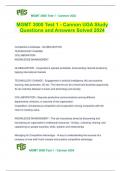MGMT 3000 Test 1 - Cannon UGA
MGMT 3000 Test 1 - Cannon UGA Study
Questions and Answers Solved 2024
Competitive Landscape - GLOBALIZATION
TECHNOLOGY CHANGE
COLLABORATION
KNOWLEDGE MANAGEMENT
GLOBALIZATION - Corporations operate worldwide, transcending national borders by
tapping international markets
TECHNOLOGY CHANGE - Engagement in artificial intelligence (AI) and machine
learning, data protection, 5G etc. The internet can be a threat and business opportunity.
AI can interfere between humans and technology and society
COLLABORATION - Requires productive communications among different
departments, divisions, or subunits of the organization.
Coopetition: simultaneous competition and cooperation among companies with the
intent of creating value.
KNOWLEDGE MANAGEMENT - The set of practices aimed at discovering and
harnessing an organization's intellectual resources - finding , unlocking, sharing, and
capitalizing on people expertise, skills, wisdom and relationships
Managing for Competitive Advantage - •A key to understanding the success of a
company is how well it both creates and sustains competitive advantage
MGMT 3000 Test 1 - Cannon UGA
, MGMT 3000 Test 1 - Cannon UGA
The fundamental drivers of competitive advantage contributors to bottom-line
organizational performance are innovation, quality, service, speed, cost
competitiveness, and sustainability.
Innovation
Quality
Service
Speed
Cost Effectiveness
Sustainability
Innovation - Innovation comes from people and must be a strategic goal.
A firm must:
Adapt to changes in consumer demands and to new competitors.
Continually innovate—especially important in the global marketplace.
Quality - Quality is the excellence of your product (goods or services).
Customers expect high-quality goods and services, and often they will accept nothing
less. Quality can be measured in terms of product performance, customer service,
reliability (avoidance of failure or breakdowns), conformance to standards, durability,
and aesthetics.
Historically, quality referred to attractiveness, lack of defects, and dependability.
Today it is about preventing defects before they occur, achieving zero defects in
manufacturing, and designing products for quality.
A philosophy of continuous improvement
MGMT 3000 Test 1 - Cannon UGA
, MGMT 3000 Test 1 - Cannon UGA
Speed - Speed:Fast and timely execution, response, and delivery of products.
Service - Continually meeting the needs of customers and establishing mutually
beneficial long-term relationships.
Making it easy and enjoyable for the customer.
Giving customers what they want or need, when they want it.
Cost competitiveness - Keeping costs low to achieve profits and be able to offer prices
that are attractive to consumers.
Companies must pay close attention to cost because consumers can compare prices
from thousands of competitors.
Sustainability - Minimizing the use and loss of resources, especially those that are
polluting and nonrenewable.
in this text we emphasize a long-term perspective on sustaining the natural environment
and building tomorrow's business opportunities while effectively managing today's
business,
Sources of Competitive Advantage - Innovation, Quality, Service, Speed, Cost
Competitiveness
IN & Out Burger
The company's view on product quality encompasses not just ingredients, but also the
satisfaction of regional consumer preferences. Consumers flock to In-N-Out Burger
stores based on the ability of the company's products to match the preferences of
MGMT 3000 Test 1 - Cannon UGA
, MGMT 3000 Test 1 - Cannon UGA
different cultural groups in the region. For example, Latin American and Asian American
consumers' preference for spice is accounted for in the company's food products.
Four Functions of Management - planning
organizing
leading
controlling
Planning - Delivering strategic value
•Systematically making decisions about goals and activities to be pursued.
Organizing - Building a dynamic organization
•Assembling and coordinating resources needed to achieve goals.
Leading - Mobilizing people
•Efforts to stimulate high performance by employees.
Controlling - Learning and Changing
•Monitoring performance and making needed changes.
Three levels of management - top managers, middle managers, Front-line managers
Top-level managers - The senior executives of an organization and are responsible for
its overall management. Often referred to as strategic managers.
Middle-level managers - located in the organization's hierarchy below top-level
management and above the frontline managers. Sometimes called tactical managers,
MGMT 3000 Test 1 - Cannon UGA




